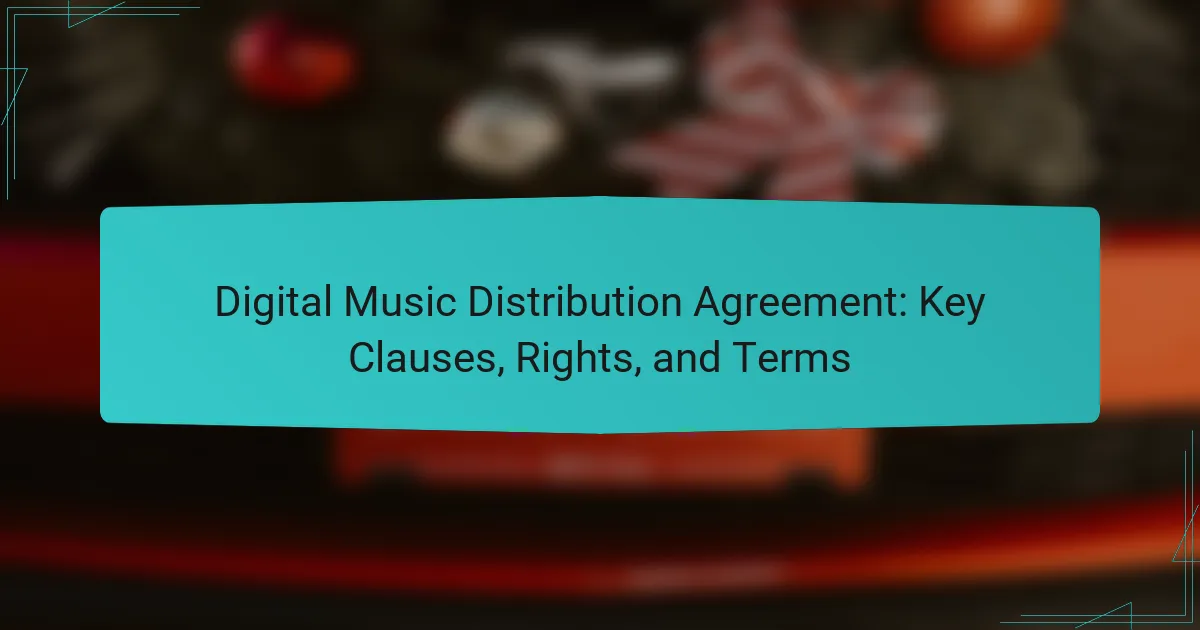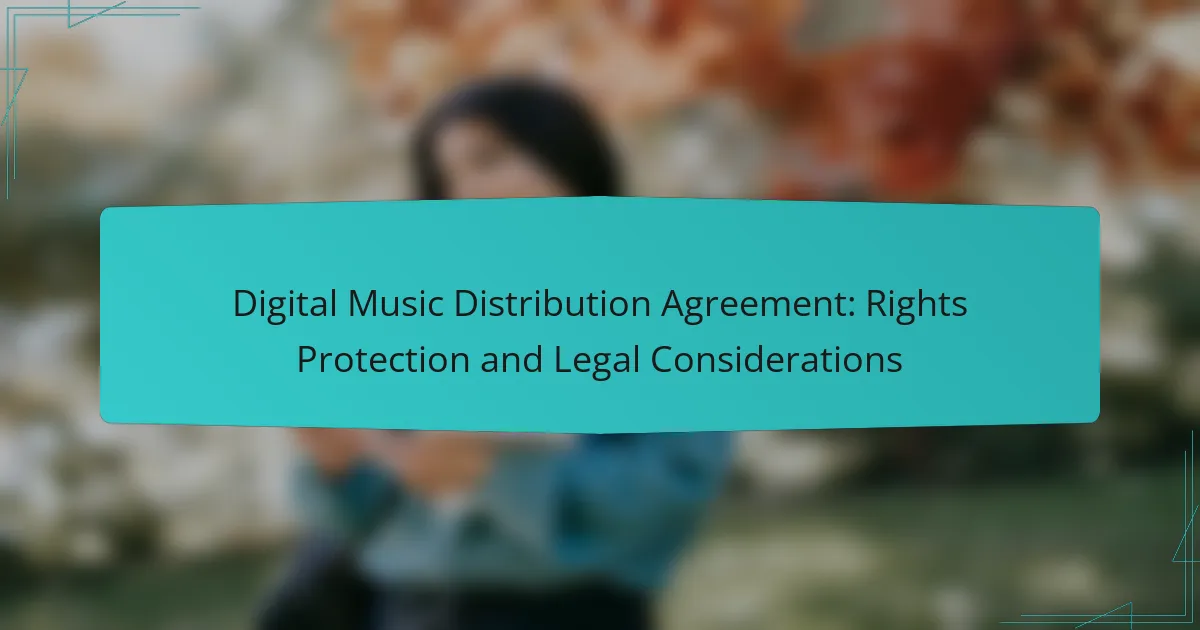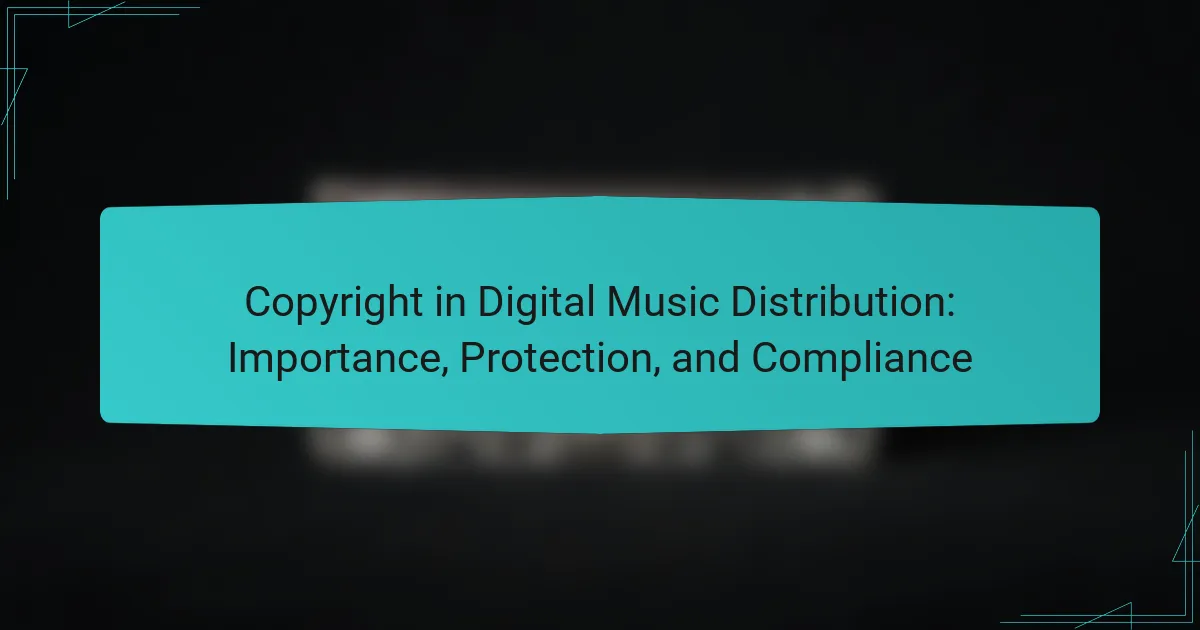A digital music distribution agreement is a vital document that defines the relationship between artists and distributors, detailing key clauses such as rights granted, payment terms, and duration. These agreements ensure that artists retain important rights, including copyright ownership and control over licensing, while also clarifying how and when they will be compensated for their music. Understanding these elements is essential for artists to protect their creative and financial interests.

What are the key clauses in a digital music distribution agreement?
A digital music distribution agreement typically includes essential clauses that outline the rights and responsibilities of both the artist and the distributor. Key clauses cover rights granted, payment terms, duration, termination conditions, and indemnification, all of which are crucial for a clear understanding of the partnership.
Rights granted to the distributor
The rights granted to the distributor usually include the ability to distribute the music across various platforms, such as streaming services and digital stores. This may also encompass the right to license the music for use in films, commercials, or other media, depending on the agreement’s scope.
Artists should carefully review these rights to ensure they retain control over their work and understand any limitations on how their music can be used. Negotiating these rights can significantly impact future revenue streams and exposure.
Payment terms and royalties
Payment terms outline how and when the artist will receive royalties from sales and streams. Typically, distributors take a percentage of the revenue, which can range from low tens to high twenties percent, depending on the services provided.
Artists should seek clarity on the frequency of payments, reporting methods, and any potential fees that might affect their earnings. Understanding these terms helps avoid surprises and ensures fair compensation for the artist’s work.
Duration of the agreement
The duration of the agreement specifies how long the distributor will have the rights to distribute the music. This period can vary widely, often ranging from one year to several years, with options for renewal or termination.
Artists should consider whether the duration aligns with their career plans and if they have the option to withdraw their music after a certain period. Shorter agreements may offer more flexibility, while longer terms can provide stability in distribution.
Termination conditions
Termination conditions detail the circumstances under which either party can end the agreement. Common conditions include breaches of contract, failure to meet payment obligations, or mutual consent.
Artists should ensure that the termination clauses are fair and allow for a smooth exit if necessary. Understanding these conditions can prevent prolonged disputes and protect the artist’s interests.
Indemnification clauses
Indemnification clauses protect one party from legal claims arising from the other party’s actions. In a digital music distribution agreement, this often means that the artist may need to indemnify the distributor against claims related to copyright infringement or other legal issues.
Artists should carefully assess these clauses to understand their potential liabilities. It’s advisable to seek legal counsel to negotiate terms that minimize risk and ensure a balanced agreement.
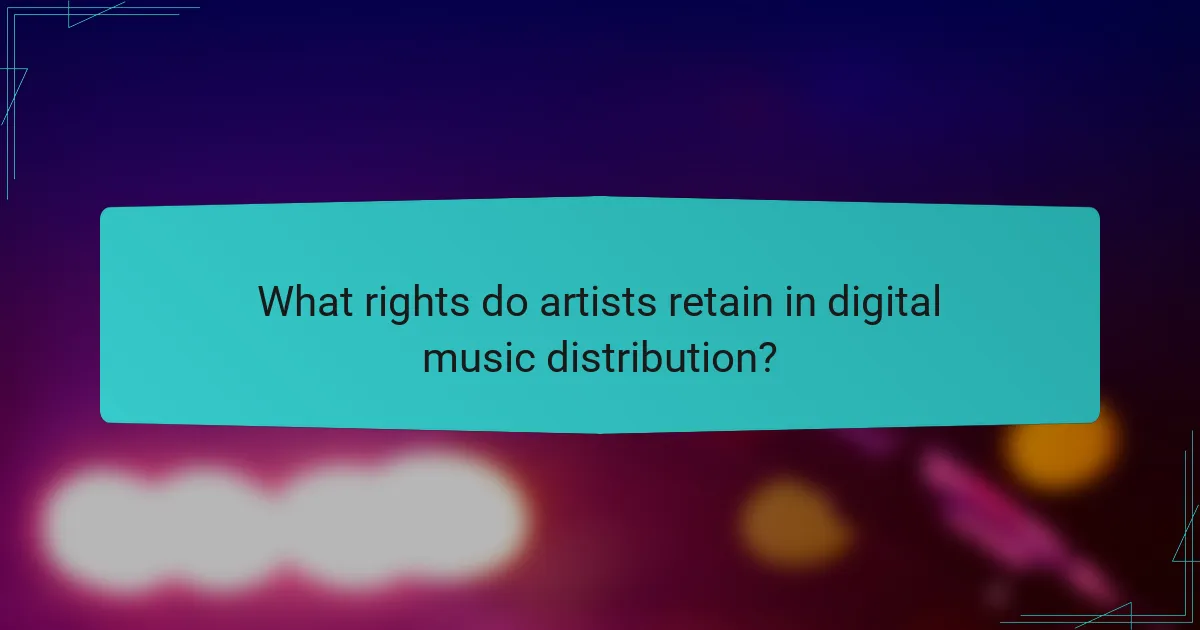
What rights do artists retain in digital music distribution?
Artists typically retain several key rights in digital music distribution, including copyright ownership, control over licensing, and distribution rights. Understanding these rights is crucial for artists to maintain their creative and financial interests in their work.
Copyright ownership
Copyright ownership allows artists to control how their music is used and distributed. Generally, artists retain copyright unless they explicitly transfer it to a distributor or label. This ownership enables them to earn royalties from various uses of their music, such as streaming, downloads, and licensing for films or commercials.
Artists should ensure that any distribution agreement clearly states their copyright status. Retaining copyright can lead to higher earnings, as artists can negotiate terms directly with platforms or third parties.
Control over licensing
Control over licensing means artists can decide how their music is licensed for use in other media. This includes granting permission for sync licenses in movies, TV shows, or advertisements. By maintaining this control, artists can maximize their revenue streams and ensure their music is used in ways that align with their brand.
It’s advisable for artists to include clauses in their distribution agreements that outline their rights to approve or deny licensing requests. This helps prevent unauthorized uses that could damage their reputation or dilute their brand.
Distribution rights
Distribution rights refer to an artist’s ability to decide where and how their music is distributed. Artists can choose to distribute their music through various platforms, including streaming services, digital downloads, and physical sales. Retaining these rights allows artists to strategically select platforms that best fit their audience and marketing goals.
When entering a distribution agreement, artists should review the terms regarding exclusivity and duration. Non-exclusive agreements can provide more flexibility, allowing artists to distribute their music across multiple platforms simultaneously, thus reaching a wider audience.
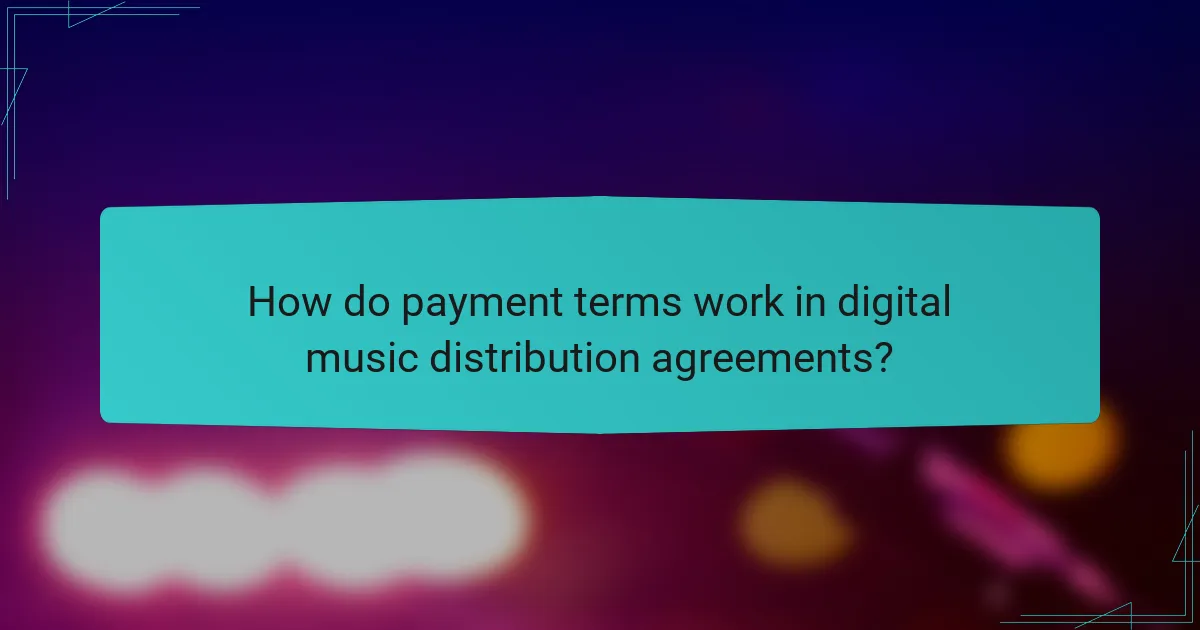
How do payment terms work in digital music distribution agreements?
Payment terms in digital music distribution agreements outline how and when artists receive compensation for their music. Understanding these terms is crucial for artists to ensure they are fairly compensated for their work.
Royalty percentages
Royalty percentages determine how much of the revenue generated from music sales or streams is paid to the artist. Typically, these percentages can range from 10% to 30%, depending on the distributor and the specific agreement. It’s essential for artists to negotiate these rates to maximize their earnings.
Some distributors offer higher percentages for exclusive agreements or for artists with a significant following. Always review the contract to understand how royalties are calculated, including any deductions for fees or costs.
Payment frequency
Payment frequency refers to how often artists receive their earnings from digital music distribution. Common payment schedules include monthly, quarterly, or biannual payments. Artists should choose a distributor that aligns with their cash flow needs.
It’s important to note that payment frequency can be influenced by the distributor’s policies and the volume of sales. Artists should clarify the timing of payments and any potential delays in their contracts.
Advance payments
Advance payments are upfront sums given to artists before their music generates revenue. These payments can provide immediate financial support but are typically recouped from future royalties. Artists should weigh the benefits of receiving an advance against the potential long-term impact on their earnings.
When negotiating advance payments, consider the amount offered and the terms for recoupment. A larger advance may seem appealing, but it could lead to lower overall earnings if not managed carefully.

What are the common terms in digital music distribution agreements?
Digital music distribution agreements typically include key terms that define the relationship between artists and distributors. Common clauses address rights, revenue sharing, and obligations, ensuring both parties understand their roles in the distribution process.
Exclusivity clauses
Exclusivity clauses specify whether the distributor has exclusive rights to distribute the artist’s music. An exclusive agreement means the artist cannot work with other distributors for the duration of the contract, which can enhance the distributor’s commitment but may limit the artist’s options.
When negotiating exclusivity, artists should consider the length of the term and the potential impact on their reach. A common practice is to set exclusivity for a specific period, such as one to three years, after which the artist can explore other distribution avenues.
Territorial restrictions
Territorial restrictions define the geographical areas where the distributor can sell or promote the artist’s music. These clauses can limit distribution to specific countries or regions, impacting the artist’s global reach.
Artists should evaluate the territories included in the agreement. For example, a distributor may have rights only in North America, while another might cover Europe and Asia. Understanding these restrictions is crucial for maximizing audience engagement and sales.
Reporting requirements
Reporting requirements outline how and when the distributor must provide sales and performance data to the artist. These clauses ensure transparency and allow artists to track their earnings and the effectiveness of their distribution strategy.
Typically, distributors are required to report sales figures quarterly or biannually. Artists should seek clarity on the format of these reports and any potential fees associated with accessing detailed performance data. Regular reporting helps artists make informed decisions about their marketing and distribution efforts.

What are the prerequisites for entering a digital music distribution agreement?
Before entering a digital music distribution agreement, artists and labels must ensure they have completed music production and hold the necessary rights to distribute their work. This includes having finalized recordings and ownership or authorization for all included content.
Completed music production
Having completed music production means that the tracks are fully recorded, mixed, and mastered. This stage is crucial as it ensures that the music meets industry standards for quality and is ready for distribution across various platforms.
Artists should consider the costs associated with production, which can vary widely based on studio time, producer fees, and additional services like mastering. A budget of a few hundred to several thousand dollars is common, depending on the project’s scope.
It is also essential to have all necessary elements in place, such as album artwork and metadata, which are required for digital distribution. Ensuring these components are finalized can prevent delays in the release process.
